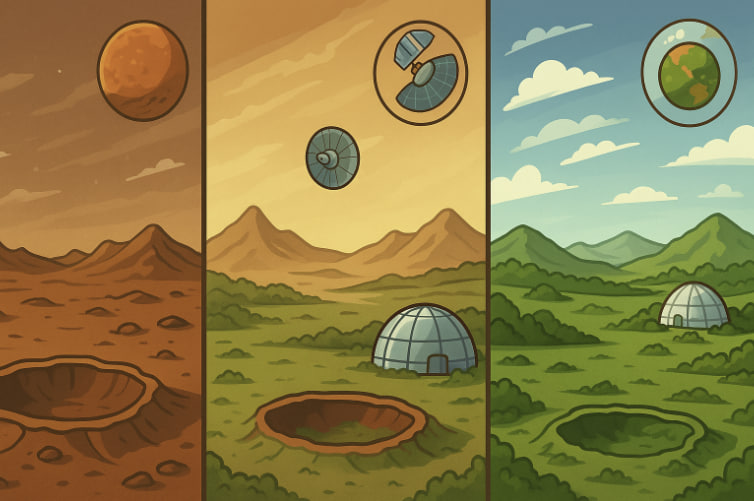The idea of terraforming Mars — transforming the Red Planet into a habitable world for humans — has captivated scientists, visionaries, and science fiction writers for decades. With interest in Mars colonization growing thanks to agencies like NASA and companies like SpaceX, the question arises: can we really change an entire planet’s environment to make it Earth-like? This article explores what terraforming Mars would involve, the scientific challenges, and how realistic this vision actually is.
What Is Terraforming?
Terraforming refers to the process of altering a planet’s atmosphere, temperature, surface, or ecology to make it more suitable for human life. In the case of Mars, that would mean:
- Raising surface temperatures
- Increasing atmospheric pressure
- Introducing breathable gases (mainly oxygen)
- Creating liquid water on the surface
- Possibly developing plant life or even ecosystems
Why Mars?
Mars is considered the best candidate for terraforming in our solar system because:
- It has day and night cycles similar to Earth (24.6 hours)
- There are polar ice caps that contain water and carbon dioxide
- Its surface has structures that resemble dry riverbeds and lakes
- Mars is relatively close to Earth (six to nine months by spacecraft)
However, it also has extreme drawbacks.
Major Challenges of Terraforming Mars
1. Atmosphere
Mars has a very thin atmosphere made mostly of carbon dioxide, with a surface pressure less than 1% of Earth’s. Humans couldn’t breathe it, and water would instantly evaporate or freeze.
To fix this:
- We’d need to release massive amounts of CO₂ into the atmosphere to trigger a greenhouse effect.
- But recent studies suggest Mars doesn’t have enough accessible CO₂ to warm the planet significantly.
2. Temperature
Mars is cold, with average temperatures around –63°C (–81°F). Warming it would require:
- Giant orbital mirrors to reflect sunlight
- Factories to pump out powerful greenhouse gases
- Nuclear explosions in the poles (a controversial idea)
This process could take centuries to millennia, even with advanced technology.
3. Magnetic Field
Earth’s magnetic field protects us from solar radiation. Mars lost its magnetic field billions of years ago, exposing the surface to harmful cosmic and solar radiation.
Without protection:
- The atmosphere would continue to erode into space
- Humans would need to live in shielded habitats or underground
- Terraforming efforts could be undone over time
4. Oxygen and Breathable Air
Even if Mars had Earth-like temperatures and pressure, its atmosphere wouldn’t be breathable. Producing oxygen on a planetary scale would require:
- Massive biological or chemical oxygen generators
- Photosynthetic organisms, possibly engineered algae
- Centuries of transformation
Alternative Ideas and Partial Solutions
Localized Terraforming (Paraterraforming)
- Creating sealed habitats or domed cities with Earth-like environments
- More feasible in the short term and requires less planetary change
- Could act as a first step toward broader terraforming
Artificial Magnetosphere
- NASA has proposed placing a giant magnetic shield at Mars’ L1 point to reduce atmospheric loss
- Still highly theoretical, but could be a game-changer
Is Terraforming Mars Realistic?
In theory, yes — the basic principles of warming a planet and generating an atmosphere are grounded in science.
In practice, not yet — and perhaps not for centuries.
Barriers include:
- Technological limitations
- Enormous energy and material requirements
- Long time scales
- Ethical and ecological concerns
Ethical Questions to Consider
- Should we modify another planet before we fix Earth?
- Could we harm any existing Martian life or geological features?
- Who would control and benefit from a terraformed world?
Conclusion
Terraforming Mars remains a fascinating scientific vision, but it’s not something humanity can achieve in the near future. While small steps — like creating enclosed habitats and producing oxygen — may happen within decades, transforming Mars into a second Earth is still a dream. It’s a dream worth exploring, but not one to rely on as an escape from solving Earth’s environmental crises.
Glossary
- Terraforming – modifying a planet to make it habitable for humans
- Greenhouse effect – the warming of a planet by trapping heat with gases
- Atmospheric pressure – the force exerted by a planet’s atmosphere at its surface
- Magnetosphere – a protective magnetic field surrounding a planet
- Paraterraforming – building enclosed habitats with life-supporting environments


